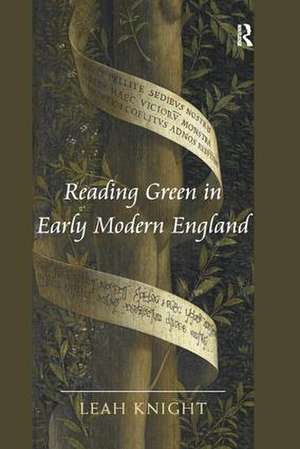Reading Green in Early Modern England
Autor Leah Knighten Limba Engleză Paperback – 26 aug 2016
Preț: 469.34 lei
Nou
Puncte Express: 704
Preț estimativ în valută:
89.84€ • 97.62$ • 75.51£
89.84€ • 97.62$ • 75.51£
Carte tipărită la comandă
Livrare economică 21 aprilie-05 mai
Preluare comenzi: 021 569.72.76
Specificații
ISBN-13: 9781138270381
ISBN-10: 1138270385
Pagini: 180
Dimensiuni: 156 x 234 x 10 mm
Greutate: 0.45 kg
Ediția:1
Editura: Taylor & Francis
Colecția Routledge
Locul publicării:Oxford, United Kingdom
ISBN-10: 1138270385
Pagini: 180
Dimensiuni: 156 x 234 x 10 mm
Greutate: 0.45 kg
Ediția:1
Editura: Taylor & Francis
Colecția Routledge
Locul publicării:Oxford, United Kingdom
Notă biografică
Leah Knight is Associate Professor of English at Brock University, Canada. Her study Of Books and Botany in Early Modern England was the winner of the British Society for Literature and Science (BSLS) Book Prize for 2009.
Recenzii
Prize: Winner of the British Society for Literature and Science Book Prize 2014 'Leah Knight’s Reading Green in Early Modern England is fresh, energetic, and rich in historical detail without forfeiting lucidity or personal voice. Readers will learn, in eco-friendly but unpolemical terms, about how exterior nature entered interior design, about the salubrious functions of green light for the eyes and flowery air for the lungs, about dancing trees and inscribed trees, and about how all these traditions shaped the scientific and literary writings of the period.' Robert N. Watson, Neikirk Distinguished Professor of English, UCLA 'We may think that the virtues of being 'green'--as an attitude towards the world and a philosophical and political movement--are essentially metaphorical, but in Knight's wide-ranging and penetrating analysis we see just how literally the early moderns took all things green. For the senses of sight, smell and hearing and the intellectual activities of reading and writing (and their associated acts of naming and carving), Knight shows that the green world was a powerfully charged agent of individual and collective good. All explorers of early modern ideas about our relationship with the natural world are in Knight's debt for this meticulous and perceptive study.' Gabriel Egan, Professor of Shakespeare Studies and the author of Green Shakespeare and the forthcoming Shakespeare and Ecocritical Theory ’... Knight connects seeing, breathing, painting, carving, and Early Modern literary culture. ... this detailed study will prove informative for those interested in Early Modern English concepts of the natural environment and human sensory perception. Summing Up: Recommended. Graduate students, faculty, researchers.' Choice 'Knight has produced an experimental, original, and fascinating book whose underlying messages suggests all criticism bears a green imprint.' Review of English Studies '... quirky, well-informed and literary ... [The book
Cuprins
Introduction: First Impressions; I: Impressed by Nature; 1: Seeing Green: Early Modern Optics on Gardens of Verse; 2: Breathing Green: Airs, Pollution, and the Green Solution; II: Impressing Nature; 3: Moving Green: Rhetorical Motivation and Botanical Animation; 4: Writing Green: Inscribing Early Modern Trees; III: Lasting Impressions; 5: Healing Green: Or, How Andrew Marvell Read Gerard's Herbal; 6: Conclusion: Easy Being? Green in Early Modern England
Descriere
Ranging across contexts from early modern optics and olfaction to horticultural grafting and herbal health care, this book offers a cultural history of a color. It mines many pages from the period - not literally but tropically, metaphorically green - that cultivate a variety of unexpected meanings of green and the atmosphere and powers it exuded in the early modern world.
